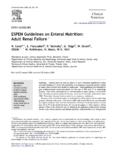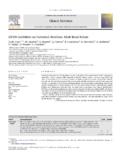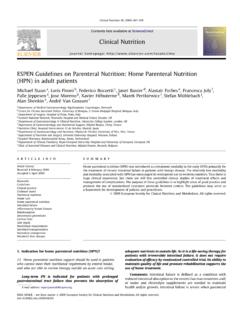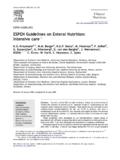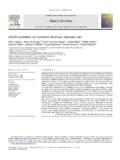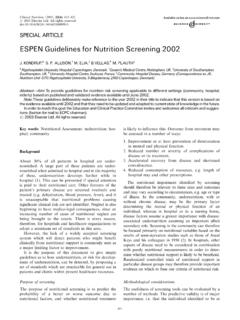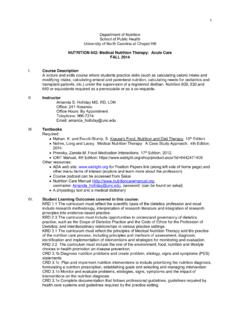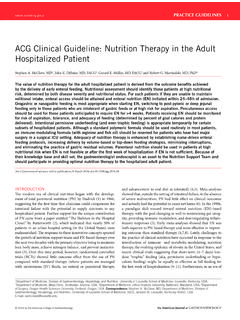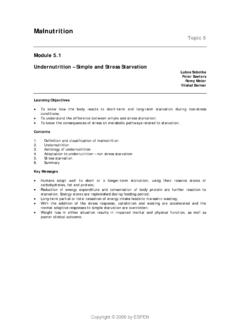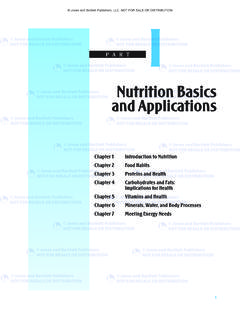Transcription of ESPEN Guidelines on Enteral Nutrition: Geriatrics
1 Clinical nutrition (2006)25, 330 360 ESPEN GUIDELINESESPEN Guidelines on Enteral nutrition : Geriatrics $D. Volkerta, ,1, Bernerb, E. Berryc, T. Cederholmd, P. Coti Bertrande,A. Milnef, J. Palmbladg, St. Schneiderh, L. Sobotkai, Z. Stangaj,DGEM:$$R. Lenzen-Grossimlinghaus, U. Krys, M. Pirlich, B. Herbst,T. Schu tz, W. Schro er, W. Weinrebe, J. Ockenga, H. LochsaHead Medical Science Division, Pfrimmer-Nutricia, Erlangen, GermanybHead geriatric Department, Meir Hospital, Kfar Saba, IsraelcDepartment of Human nutrition & Metabolism, Hebrew University, Hadassah Med School,Jerusalem, IsraeldDepartment of Public Health and Caring Science, Uppsala University, Uppsala, SwedeneUnite de nutrition Clinique, CHUV, Lausanne, SwitzerlandfHealth Services Research Unit, University of Aberdeen, Aberdeen, UKgDepartment of Medicine, Karolinska Institute, Huddinge University Hospital, Huddinge, SwedenhGastroente rologie et nutrition Clinique, Hopital de l Archet, Nice, FranceiMetabolic Care Unit, Department of Gerontology and Metabolic Care, Charles University,Faculty of Medicine, Hradec Kralove, Czech RepublicjInternal Medicine and Clinical nutrition , Inselspital/University Hospital, Bern, SwitzerlandReceived 18 January 2006.
2 Accepted 19 January 2006 KEYWORDSG uideline;Clinical practice;Evidence-based;Recommendations; SummaryNutritional intake is often compromised in elderly, multimorbidpatients. Enteral nutrition (EN) by means of oral nutritional supplements (ONS)and tube feeding (TF) offers the possibility to increase or to insure nutrient intake incase of insufficient oral food present guideline is intended to give evidence-based recommendations forthe use of ONS and TF in geriatric patients. It was developed by an interdisciplinaryexpert group in accordance with officially accepted standards and is based on allARTICLE IN $ - see front matter&2006 European Society for Clinical nutrition and Metabolism. All rights :ADL, activities of daily living; BCM, body cell mass; BMI, body-mass index; CI, confidence interval; EN, enteralnutrition; FFM, fat-free mass; IADL, instrumental activities of daily living; MAC, mid-arm circumference; MAMC, mid-arm musclecircumference; NGT, nasogastric tube; ONS, oral nutritional supplement; OR, odds ratio; PEG, percutaneous endoscopic gastrostomy;RR, relative risk; SD, standard deviation; TF, tube feeding; TSF, triceps skin fold$For further information on methodology see Schu tz et further information on definition of terms see Lochs et Corresponding author.
3 Tel.: +49 9131 7782 31; fax: +49 9131 7782 (D. Volkert).1 Dorothee Volkert had been employed at the Department of nutrition Science, University of Bonn, until May 31, 2005; she was notindustry employed during the development of the Guidelines .$$The authors of the DGEM (German Society for Nutritional Medicine) Guidelines on Enteral nutrition in Geriatrics areacknowledged for their contribution to this nutrition ;Oral nutritionalsupplements;Tube feeding; geriatric patients;Undernutrition;Malnutrition;Eld erly;Aged-80-and-overrelevant publications since 1985. The guideline was discussed and accepted in aconsensus by means of ONS is recommended for geriatric patients at nutritional risk, incase of multimorbidity and frailty, and following orthopaedic-surgical procedures. Inelderly people at risk of undernutrition ONS improve nutritional status and reducemortality.
4 After orthopaedic-surgery ONS reduce unfavourable outcome. TF is clearlyindicated in patients with neurologic dysphagia. In contrast, TF is not indicated infinal disease states, including final dementia, and in order to facilitate patient , it is strongly recommended not to wait until severe undernutrition hasdeveloped, but to start EN therapy early, as soon as a nutritional risk full version of this article is available European Society for Clinical nutrition and Metabolism. All rights IN PRESSS ummary of statements: GeriatricsSubjectRecommendationsGrade173 NumberIndicationsIn patients who areundernourished or at risk ofundernutritionuse oral nutritional supplementation toincrease energy, protein and micronutrient intake,maintain or improve nutritional status, and frail elderlyuse oral nutritional supplements (ONS) toimprove or maintain nutritional elderlymay benefit from TF as long as their generalcondition is stable (not in terminal phases of illness).
5 geriatric patients withsevere neurological dysphagiause Enteral nutrition (EN) to ensure energy and nutrientsupply and, thus, to maintain or improve geriatric patientsafter hip fracture and orthopaedicsurgeryuse ONS to reduce EN to overcome the phase of severeanorexia and loss of patientsONS or tube feeding (TF) may leadto an improvement of nutritional and moderate dementiaconsider ONS andoccasionally TF to ensure adequate energy and nutrientsupply and to prevent patients withterminal dementia, tube feeding is patients with dysphagia theprevention of aspirationpneumoniawith TF is not , particularly with high protein content, can reducethe risk ofdeveloping pressure on positive clinical experience, EN is alsorecommended in order to improvehealing of Guidelines on Enteral Nutrition331 ARTICLE IN PRESSA pplicationIn case ofnutritional risk( insufficient nutritionalintake, unintended weight loss45% in 3 months or410%in 6 months, body-mass index (BMI)o20 kg/m2)
6 Initiateoral nutritional supplementation and/or TF geriatric patients withsevere neurological dysphagiaEN has to be initiated as soon as geriatric patients withneurological dysphagiaaccompany EN by intensive swallowing therapy until safeand sufficient oral intake is Enteral nutrition 3 hours after PEG geriatric patients withneurological dysphagiapreferpercutaneous endoscopic gastrostomy (PEG) tonasogastric tubes (NGT) for long-term nutritional support,since it is associated with less treatment failures andbetter nutritional a PEG tube if EN is anticipated for longer than offormulaDietary fibre can contribute to the normalisation of bowelfunctions in tube-fed elderly : Grade of recommendation; Number: refers to statement number within the patient a biologically elderly patient who is at acute risk of loss of independence due to acuteand/or chronic diseases (multiple pathology) with related limitations in physical, psychological, mentaland/or social functions.
7 The abilities to perform the basic activities of independent daily living arejeopardised, diminished or lost. The person is in increased need of rehabilitative, physical, psychologicaland/or social care to avoid partial or complete loss of a term used to describe a particular age group, over 65 old or very elderly a term to describe those over 85 years of elderly Frail elderly are limited in their activities of daily living due to physical, mental,psychological and/or social impairments as well as recurrent disease. They suffer from multiple pathologieswhich seriously impair their independence. They are therefore in particular need of help and/or care and arevulnerable to capacity for rehabilitation This means that the older the patient, the more difficult it is torehabilitate that patient back to normal or to his/her previous state. Specifically, the restoration ofmuscle mass after illness requires much greater effort in terms of exercise and nutrition in the elderlycompared with the younger patient.
8 It is also implicit that other functions, including mental, are similarlymore resistant to status This term is being used in a general sense to describe global function, the abilityto perform activities of daily living (ADL), or specific function, muscle strength or immune risk of undernutrition is increased in elderlypatients due to their decreased lean body mass andto many other factors that may compromisenutrient and fluid intake. Consequently, an ade-quate intake of energy, protein and micronutrientshas to be ensured in each patient independently ofhis/her previous nutritional status. Since restorationof body cell mass (BCM) is more difficult than inyounger persons, preventive nutritional support hasto be care should be integrated appropri-ately into the overall care plan, which takes intoD. Volkert et all aspects of the patient, personal, social,physical and psychological.
9 A complete assessment ofthe patient should include that of nutritional status orrisk, followed by a nutritional programme reflectingethical as well as clinical considerations. In designingthe programme, it should be remembered that themajority of sick elderly patients require at least 1 gprotein/kg/day and around 30 kcal/kg/day of energy,depending on their activity. Many elderly people alsosuffer from specific micronutrient deficiencies, whichshould be corrected by nutritional therapy via assisted feeding anddietary supplements is often difficult, time-con-suming and demanding in elderly patients (due tomultimorbidity and slow responses). However,assisted oral feeding and supplements are able tosupport the physical and psychological rehabilita-tion of most elderly patients. Therefore, even intimes of declining financial and human resources, itis unacceptable to initiate tube feeding (TF) merelyin order to facilitate care or save making concerning TF in the elderly isoften difficult, and in many cases ethical questionsarise (see Guidelines Ethical and legal aspectsin Enteral nutrition ).
10 In each case, the followingquestions should be asked: Does the patient suffer from a condition that islikely to benefit from Enteral nutrition (EN)? Will nutritional support improve outcome and/oraccelerate recovery? Does the patient suffer from an incurabledisease, but one in which quality of life andwellbeing can be maintained or improved by EN? Does the anticipated benefit outweigh thepotential risks? Does EN accord with the expressed or presumedwill of the patient, or in the case of incompetentpatients, of his/her legal representative? Are there sufficient resources available to manageEN properly? If long-term EN implies a differentliving situation ( institution vs. home), will thechange benefit the patient overall?Sedation of the patient for acceptance of thenutritional treatment is not present Guidelines are based on studies inelderly subjects or in those in whom the averageage of the study participants is 65 years or What are the aims of EN therapy ingeriatrics?

